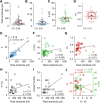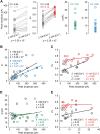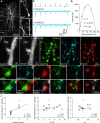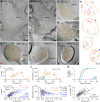Variability in the Munc13-1 content of excitatory release sites
- PMID: 33904397
- PMCID: PMC8116053
- DOI: 10.7554/eLife.67468
Variability in the Munc13-1 content of excitatory release sites
Abstract
The molecular mechanisms underlying the diversity of cortical glutamatergic synapses are still incompletely understood. Here, we tested the hypothesis that presynaptic active zones (AZs) are constructed from molecularly uniform, independent release sites (RSs), the number of which scales linearly with the AZ size. Paired recordings between hippocampal CA1 pyramidal cells and fast-spiking interneurons in acute slices from adult mice followed by quantal analysis demonstrate large variability in the number of RSs (N) at these connections. High-resolution molecular analysis of functionally characterized synapses reveals variability in the content of one of the key vesicle priming factors - Munc13-1 - in AZs that possess the same N. Replica immunolabeling also shows a threefold variability in the total Munc13-1 content of AZs of identical size and a fourfold variability in the size and density of Munc13-1 clusters within the AZs. Our results provide evidence for quantitative molecular heterogeneity of RSs and support a model in which the AZ is built up from variable numbers of molecularly heterogeneous, but independent RSs.
Keywords: hippocampus; mouse; neuroscience; patch clamp; synaptic transmission.
© 2021, Karlocai et al.
Conflict of interest statement
MK, JH, TB, NH, AL, ZN No competing interests declared
Figures










Similar articles
-
Selective Enrichment of Munc13-2 in Presynaptic Active Zones of Hippocampal Pyramidal Cells That Innervate mGluR1α Expressing Interneurons.Front Synaptic Neurosci. 2022 Feb 10;13:773209. doi: 10.3389/fnsyn.2021.773209. eCollection 2021. Front Synaptic Neurosci. 2022. PMID: 35221979 Free PMC article.
-
ELKS1 localizes the synaptic vesicle priming protein bMunc13-2 to a specific subset of active zones.J Cell Biol. 2017 Apr 3;216(4):1143-1161. doi: 10.1083/jcb.201606086. Epub 2017 Mar 6. J Cell Biol. 2017. PMID: 28264913 Free PMC article.
-
Molecular dynamics of a presynaptic active zone protein studied in Munc13-1-enhanced yellow fluorescent protein knock-in mutant mice.J Neurosci. 2006 Dec 13;26(50):13054-66. doi: 10.1523/JNEUROSCI.4330-06.2006. J Neurosci. 2006. PMID: 17167095 Free PMC article.
-
Presynaptic active zones in invertebrates and vertebrates.EMBO Rep. 2015 Aug;16(8):923-38. doi: 10.15252/embr.201540434. Epub 2015 Jul 9. EMBO Rep. 2015. PMID: 26160654 Free PMC article. Review.
-
Coupling of exocytosis and endocytosis at the presynaptic active zone.Neurosci Res. 2018 Feb;127:45-52. doi: 10.1016/j.neures.2017.09.013. Epub 2017 Dec 6. Neurosci Res. 2018. PMID: 29221907 Review.
Cited by
-
The Potential Connection between Molecular Changes and Biomarkers Related to ALS and the Development and Regeneration of CNS.Int J Mol Sci. 2022 Sep 26;23(19):11360. doi: 10.3390/ijms231911360. Int J Mol Sci. 2022. PMID: 36232667 Free PMC article. Review.
-
Differential nanoscale organization of excitatory synapses onto excitatory vs inhibitory neurons.bioRxiv [Preprint]. 2023 Sep 7:2023.09.06.556279. doi: 10.1101/2023.09.06.556279. bioRxiv. 2023. Update in: Proc Natl Acad Sci U S A. 2024 Apr 23;121(17):e2315379121. doi: 10.1073/pnas.2315379121. PMID: 37732271 Free PMC article. Updated. Preprint.
-
SNARE Regulatory Proteins in Synaptic Vesicle Fusion and Recycling.Front Mol Neurosci. 2021 Aug 6;14:733138. doi: 10.3389/fnmol.2021.733138. eCollection 2021. Front Mol Neurosci. 2021. PMID: 34421538 Free PMC article. Review.
-
Parallel processing of quickly and slowly mobilized reserve vesicles in hippocampal synapses.Elife. 2024 May 10;12:RP88212. doi: 10.7554/eLife.88212. Elife. 2024. PMID: 38727712 Free PMC article.
-
Loss of postsynaptic NMDARs drives nanoscale reorganization of Munc13-1 and PSD-95.bioRxiv [Preprint]. 2024 Jan 12:2024.01.12.574705. doi: 10.1101/2024.01.12.574705. bioRxiv. 2024. PMID: 38260705 Free PMC article. Preprint.
References
Publication types
MeSH terms
Substances
Grants and funding
LinkOut - more resources
Full Text Sources
Other Literature Sources
Molecular Biology Databases
Miscellaneous

